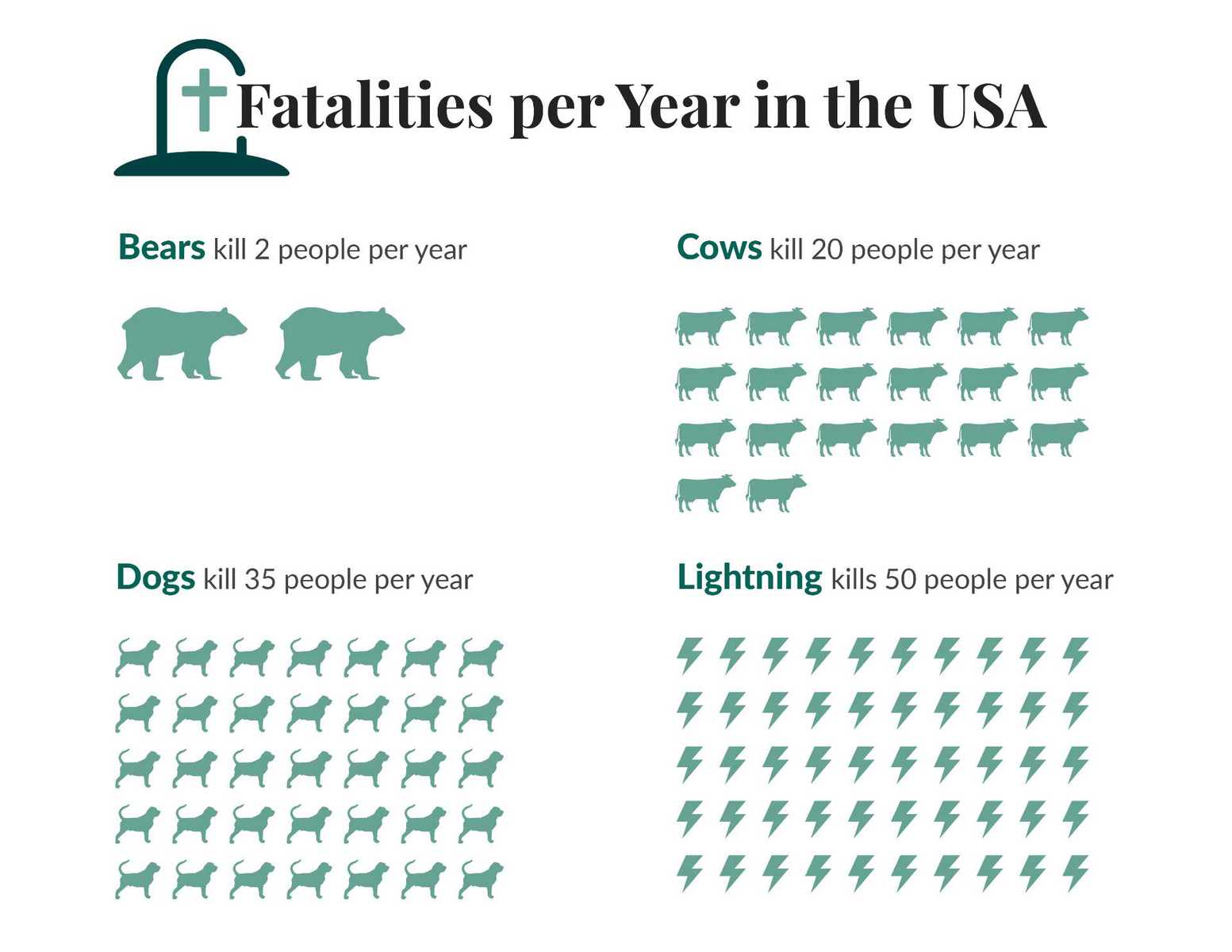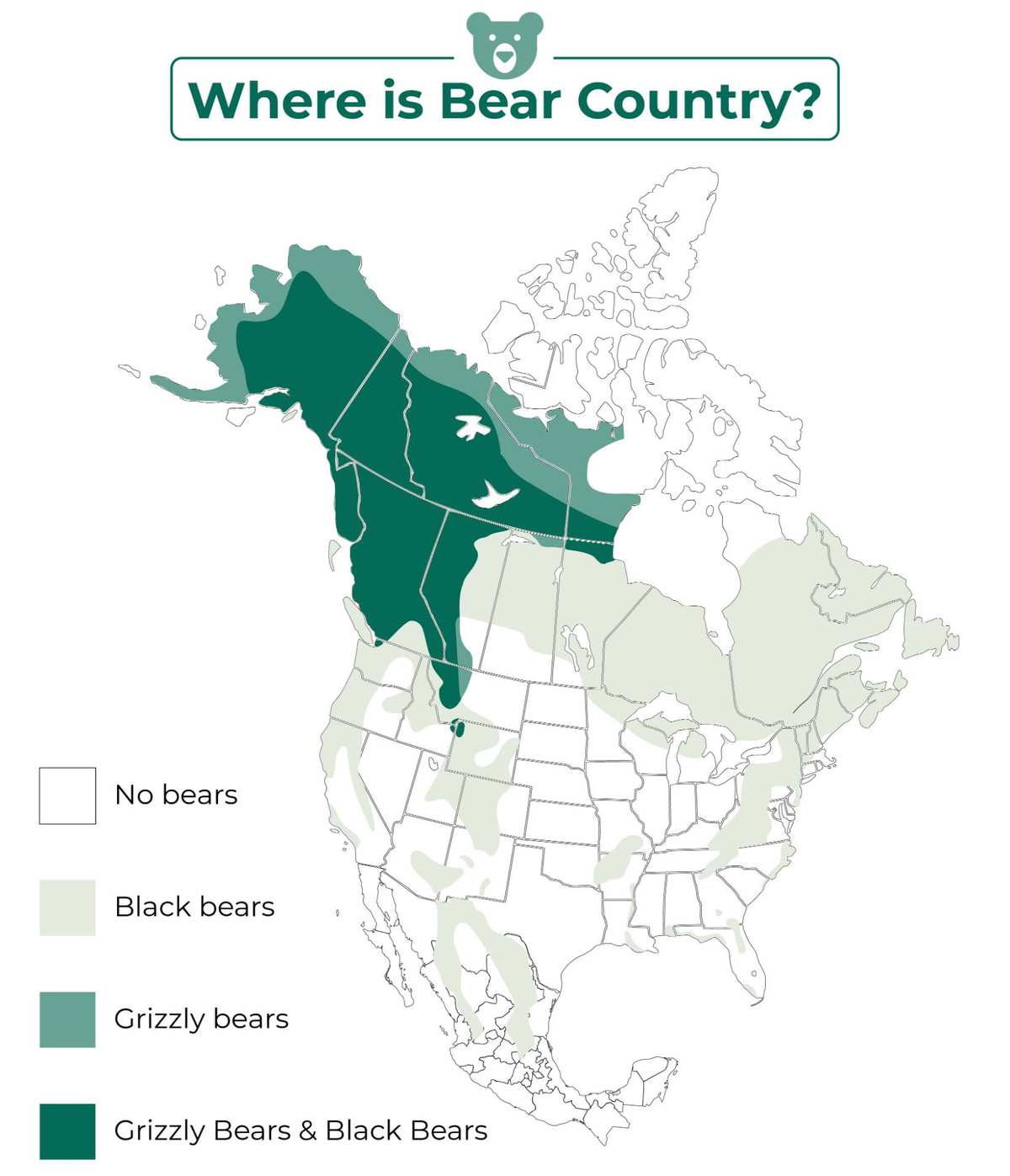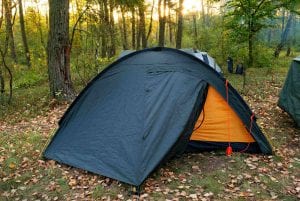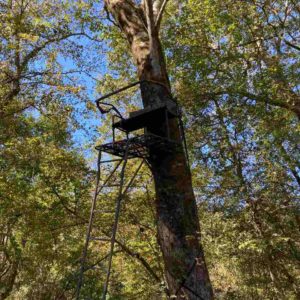When we venture outdoors we often feel vulnerable. It’s probably one of the reasons we do it, because risk and reward are such closely bonded concepts! But at the same time, most of us recognise the importance of planning and risk mitigation. So it’s no surprise that a lot of people want to know what to do if you see a bear when out and about.
This article endeavours to give a short answer (summarising what you should do in the 3 most likely bear encounters) and a much longer answer (exploring the why’s and how’s in much more depth). I’d encourage you to look at the longer answer because there is a lot of nuance and context around this topic. But if you’re short on time, here are the highlights:
Scenario 1: You see a bear but the bear doesn’t see you
Rule #1 for bear safety is to avoid an encounter altogether. If you are keeping an eye out for signs of bears and regularly scanning the horizon, there’s a chance you might spot a bear before they know you are in the area. In this situation, you want to slip away quietly.
- Stay quiet
- Keep your distance
- Consider going back the way you came
- If you proceed, give the bear a wide berth & move downwind
- Do not announce your presence
- Do not panic
- Do not run away
- Do not go upwind
Scenario 2: You see a bear and the bear sees you (but at a distance)
Again, if you are being aware of your surroundings and encounter a bear there’s a chance you’ll both notice each other from a distance. Because it’s highly unlikely it’s a predatory bear (see below), you have little to worry about. Most bear attacks are defensive in nature, so the greater the distance, the less threatened the bear will feel. In this situation, you want to reduce the threat further by leaving the area whilst discouraging the bear to follow you.
- Make your presence known by talking
- Gather any kids around you
- Make yourself look big
- Slowly back away
- Do not shout
- Do not climb a tree
- Do not remove your backpack
- Do not run
Scenario 3: You surprise a bear (or it surprises you) at close quarters
This scenario is unlikely because bears generally don’t want to be near you and they have such good senses, most times they’ll leave the area before you even know they’re there. However, they may be drawn to you because you have food (if they’re food habituated), or you might stumble into one of their feeding grounds, or any number of other reasons might result in a surprise encounter. This is obviously a very tense situation for all parties and the one most likely to result in a negative outcome if handled poorly. Your job here is to be assertive without being threatening and to leave the area without fleeing or showing fear.
- Speak assertively in low tones
- Ready your bear spray
- Wave your arms slowly to make yourself look big
- Make sure the bear has an escape route
- Retreat slowly and calmly
- Do not shout
- Do not make sudden movements
- Do not look the bear directly in the eye
- Do not run
Check out my article on the best bear spray here… >>>>
If the bear follows you, or charges you, stop and stand your ground. Keep encouraging it to keep its distance by speaking and making yourself look bigger.
If you want to understand more about these do’s and don’ts or want to read about how to deal with a bear charge, check out the longer article or click one of the quick links below…
Don’t Panic
While it’s normal to be nervous about encountering a bear while in the wilderness, the first thing you need to know is that bear attacks are extremely rare. That being said, it’s important to know exactly what to do in case it does actually happen. (Ed: Be “pre-beared”! Sorry)
How rare are bear attacks?
Bear attacks are comfortingly low, all things being considered. For example, in the USA and Canada, between 1900 and 1985, grizzly bears inflicted only about 162 injuries, many of them non life-threatening. [Source: Cardall, T. and Rosen, P. (2003). Grizzly Bear Attack. The Journal of Emergency Medicine]. That’s less than 2 attacks per year.
As for Black Bears, in the 20 years to 2017 there were 25 recorded fatalities in the United States and Canada. [Source: wideopenspaces.com]. That works out to 1.25 deaths per year. As you might expect, there were many more attacks than that but the numbers are clearly in your favor.
In fact, you’re more likely to be struck by lightning than attacked by a bear (over 500 people are struck by lightning in the USA every year). When it comes to fatalities, you’re statistically more likely to be killed by a dog or a cow than a bear…

Sources: Wikipedia, Washington Post, DogsBite.org & Weather.org
Camping Near Bears
You might be out in the wilds sleeping under a backpacking tarp or in a small tent. You might be at an established campground bunking down in a large family tent… But while you might find comfort in numbers, there are a few things you really need to do to maximise your bear safety when camping.
1. Always use proper food storage like a bear canister or a bear bag
2. Never leave food unattended
3. Always make sure your food prep area is in a separate place from your tent
4. Avoid scented soaps, smelly perfumes and stinky deodorants; bears can smell them an may be attracted to them.
If you do hear what you think is a bear outside your tent, the best thing to do is nothing. Simply ready a flashlight and your bear spray. If you’re lucky enough to be sleeping on a queen-sized camping cot, give your significant other a comforting cuddle.
You should only make a move if a bear actually attacks the tent. In that situation, do what you can to get out, fight back and start using your bear spray.
Bear Safety: How to Avoid an Encounter
If you’re worried about seeing a bear, the best thing to do is try and avoid having an encounter altogether. Here’s a few tips to help you stay well out of a bear’s way.
Where are Bears Found?
You may be familiar with the expression “fish where the fish are”. This piece of bear advice is the complete opposite. If you are worried about seeing a bear, try to hang out in areas where bears are rare or absent!
Black bears have the largest geographic range of any type of bear, found as far south as central Mexico and as far north as northern Alaska. But that doesn’t mean they live around every corner. There are often huge gaps between populations.
Grizzly bears, on the other hand, are found mostly in Alaska and northwestern Canada – although they are also found in smaller populations in northwestern Montana, Yellowstone National Park, northwestern Washington, and northern Utah.
Polar bears, the largest of all three types of bears, are only found in northern Alaska, Canada, and Greenland.

When Are Bears Most Active?
Knowing when bears are most active can help you avoid an encounter.
Because bears hibernate, you’re far less likely to come across one in the winter months.They bed down in dens such as tree cavities or hollow stumps. It’s not impossible – particularly if a den is disturbed or if there is a brief warming trend or thaw – but it is significantly less likely.
Cubs are born in late January or early February, and the females (along with these newly born cubs) emerge in late March or early April. Cubs remain with their mothers for about eighteen months, or when she mates again – whichever comes first.
If you are out and about when bears are not hibernating, then you should be aware that they most active during early morning and late evening [source: nps.gov], particularly in spring and summer. Mating occurs in July, and bears will become calmer as the fall approaches.
Other Tips to Avoid an Encounter
Of course, there’s every chance that you don’t want to limit your outdoors activities to the depths of winter and summer lunchtimes just to further reduce the already slim chance of meeting a bear. So here’s a bunch more practical tips:
Store your food properly
- Make sure you store your food and trash appropriately. While there has been a plethora of mixed advice given on this subject, the best rule of thumb is to use “bear canisters” (bear-resistant food containers) when you can. Some parks even require you to use them. [Source: nps.gov].
- Try not to store food in your your car (it can be OK as long as it is out of sight with the windows completely closed – but you should never do this overnight)
- Never store food in your tent
- Never dispose of food waste in the wilderness
Keep an eye out for signs of bears
When you’re out and about, get into the habit of scanning the horizon regularly with your pocket binoculars. Look for a large shape in the distance. While grizzly bears can be blonde to black in color, they are usually dark to medium brown. Black bears are usually black but they have a light-colored snout. Grizzly bears have distinct shoulder humps, while black bears are more evenly built.
Besides watching for the bears themselves, keep an eye out for other signs that bears are around. Tracks are a key indicator, with black bears possessing tracks with short claws and grizzly bears having longer ones. You might also find scat, grizzly diggings, carcasses, or territorial markings. You may even find bear trails in the woods.
Be vigilant at all times. Don’t let yourself zone out while you walk – this isn’t safe in general, but especially not when you are hiking in bear country.
Travel in groups
For the most part, bears want nothing to do with you. While you may enjoy some quality time alone in the wilderness, safety best practices dictate that you should travel in groups of three or more. The logic here is simple – if a bear sees you approaching alone (or if you startle it because you, by yourself, are moving so quietly), it is more likely to attack. If it sees you approaching in a large group, it will want to stay away.
In fact, Yellowstone have an ongoing longitudinal study starting in 1970 which documents that of all bear attacks in the park, 91% of them occurred when the person was hiking alone or with just one other person. [Source: nps.gov]
Make Noise
Making noise can be an effective way to deter a bear, but don’t shout. Talking with your hiking companions, or even singing quietly, can announce your presence and help keep bears away.
Be Aware of Potential Food Sources
Be mindful of the potential for bears when you are walking around any possible sources of food. Some to watch out for include:
- Berry bushes
- Fresh carcasses or other kill sites
- Any areas with large amounts of scavenger birds (indicative of a kill site)
- Ponds or streams
- Open wetland meadows
- Areas where trash or roadkill are prevalent
Get Away Immediately If You See a Cub
A mother bear that is with her cubs will be more defensive and aggressive than any other kind of bear. Therefore, your main priority if you see a mother with a cub should be to get away before she notices you. If she does, employ the techniques we will mention below to get yourself out of the situation as safely as possible.
Bear Bells: Do They Work?
A bear bell is a small bell attached to a velcro strap or carabiner that you attach to your body or backpack as you walk through the woods. These are designed to scare bears away by warning them of your approach, but unfortunately, they just don’t work.
A recent study by a scientist for the U.S. Geological Survey, Tom Smith, indicates that wild bears will largely ignore bear bells. They treat the noise produced by these bells much like they would birds or other kinds of background noise. In some cases, bear bells can even make things worse.
This interesting effect was documented in a 1985 book by Stephen Herrero. Since they don’t frighten bears, they may actually attract bears who are curious about where the jingling noise is coming from.
Long story short, bear bells may do more harm than good.
Can You Use a Whistle as a Bear Deterrent?
Whistles should not be used for the same reason that you should avoid bear bells. First, bears may be curious as to what is making the noise, and second, because whistles are usually high-pitched, they can awaken a bear’s predatory instincts.
Bear whistles, according to the Alaska Department of Fish and Game, can attract a bear to you more than they can repel it. It’s not unlike the effect of a dog that comes running when you squeeze his favorite squeaky toy! Instead, it’s better to make noise by singing, talking, or clapping as you move.
What To Do If You See a Bear
I guess I’ve really tried to hammer home the importance of trying not to see a bear. But what if that doesn’t work? What if you do see a bear? What if you surprise a bear? The most important thing is don’t panic; it’s highly unlikely a bear will want to attack you.
A Distant Encounter
If the bear is far away (say 100 yards or more), make your presence known and extract yourself calmly from the area. There are stories of people starting to yell in this situation (like this story from Norway) but it’s probably best not to go overboard. Neither party should feel particularly threatened. Just make sure to keep an eye on the situation, especially if the bear is on the move.
For example, if you spotted the bear on the trail ahead and it was moving down the trail towards you, you might consider backing up to the past intersection and taking a wide detour.
Do not run.
A Close Encounter
If you happen on a bear and it’s less than 100 yards away, both of you are likely to be somewhat surprised. But if the bear doesn’t immediately charged at you (which would be unlikely), it’s really important to try to diffuse the situation by showing you are not a threat.
Did you read the section on why bears become aggressive? About how they’ll only really threaten you if they themselves feel threatened?
Cubs. Food. Nowhere to run.
Your priority is to leave the area without showing weakness or fear. The NPS has a handy few notes on what to do if a bear finds you (read it here).
- Start by identifying yourself. Don’t yell or shout, but do use low tones that confirm to the bear that you are human
- Gather up any children in the group
- Pull out your bear spray and remove the safety
- Make yourselves look as large as possible. Puff out your chest. Perhaps move to higher ground. Spread out your arms and move them slowly up and down. Remember, the intention here is not to alarm the bear. You want to be assertive enough that the bear thinks twice about upping the ante
- Without looking the bear in the eye, making any loud noises, making any quick movements or removing your pack, start to move out of the area. Moving sideways is a good call here, as it is non threatening to the bear and it can help you avoid tripping. But if you have to retreat back the way you came, that is also OK.
If the bear follows you: Stop. Keep talking. Keep making yourself look big. The chances are it’s just curious but you should also start preparing yourself for the possibility it may charge.
Why You Should Always Carry Bear Spray in Bear Country
One of the best ways you can protect yourself against a bear attack, particularly against a grizzly bear attack, is to use bear spray. Make sure you carry bear spray with you and familiarize yourself in advance with how it works. Practice outdoors and carry the spray on you when you are traveling in bear country.
What’s in bear spray?
Bear spray is a high-pressure extraction of capsaicin. It usually contains about two percent capsaicin, which is the chemical that makes peppers hot.
How does it work?
In a 2008 study conducted for the Journal of Wildlife Management, scientists found that bear spray was effective 92% of the time in preventing attacks and 98% effective in preventing injury. [Source: Montana Fish, Wildlife & Parks]
Bear spray should be sprayed for about six to nine seconds, ideally out of a canister weight of at least 7.9 ounces. You should spray the canister about twenty-five feet away from the bear, which will give the bear the opportunity to feel the full effects of the spray.
Before you head out into the wilderness with a canister of bear spray, make sure you practice with it. Try arming the container, spraying it, and then restoring the safety clip. You should take a test spray or two so that you have mastered the technique of spraying before you actually need to use it.
What to Do if a Bear Charges
With most encounters, you’ll be trying to give the bear space; retreating slowly and leaving the area. However, that all changes the second a bear starts to charge. At that point you should stand your ground, ready your bear spray and prepare for contact.
Stand Your Ground
It will be terrifying. But be aware there’s still a really good chance contact will never be made, because there’s a big difference between a charge and an attack. The majority of charges will be bluff charges rather than aggressive charges (ones which will make contact).
“Mother bears, whenever they feel threatened or a person is too close, they act very aggressively. They make noise, they swat the ground with their paws and they run at people. They want to make you think that they’ll eat you alive, but they almost always stop.”
Stephen Herrero author of Bear Attacks: Their Causes & Avoidance, (quoted in NY Times)
Bluff Charges
Bluff charges are designed to intimidate you whilst avoiding direct contact. According to the National Park Service, a bluff charge is when a bear lifts its head and ears up and forward, trying to make itself look bigger. The bear may even start bounding toward you on its front paws – but it will ultimately charge off to one side or stop running entirely.
Check out this awesome video of a mama bear repeatedly bluff charging a researcher in the 1980s:
Bluff Charge from North American Bear Center on Vimeo.
Notice the snapping jaws and the puffing. Also note the lack of eye contact and her defensive posture when she isn’t charging. These are all signs of discomfort, but not aggression.
Sure, having her rushing at you will be scary as hell, but everything about body language says “get outta here” more than “I’m gonna kill you!”. Here’s a really good article about “bear bluster” from bear.org
Aggressive Charges
Aggressive charges will end in contact. They are extremely rare but can occur if a bear has been stalking you, has no easy escape route, or is showing other signs of predatory behavior. Aggressive attacks are more likely if a bear is sick or starving.
Signs of an imminent aggressive charge might include the bear’s ears being pointed flat back, its head pointed down and Intense staring.
“The kind of bear you need to be afraid of is not feeling threatened by you — it’s testing you out as a possible prey item. It’s quiet. It stalks you just like a lion might stalk you.”
Stephen Herrero author of Bear Attacks: Their Causes & Avoidance, (quoted in NY Times)
Reacting to a Charge
The reality is, in the heat of the moment you’ll probably have no idea if you’re facing a bluff charge or an aggressive charge. So that means you have to ready yourself for contact.
- Stand your ground
- Make yourself look as big as possible
- Up the noise level; yell and even throw things
- When the bear is about 40ft from you start to spray your bear spray so that the bear runs into the fog. [Source: udap.com]
All that should bring things to a halt.
When the bear stops or moves off to the side, go back to removing yourself from the situation. Kids behind you, arms above your head, speaking calmly… start to retreat again keeping an eye on the bear.
How To Survive a Bear Attack
In the highly unlikely situation a bear does decide to make contact, you essentially have two choices: you can play dead, or you can fight back. Your best course of action will depend on the type of bear that is attacking you, so you really need to know what you’re up against. (If you’re in an area that have Black Bears and Grizzly Bears, make sure you know the difference).
If a Black Bear Makes Contact
If a black bear attacks you, fight back with everything you have. Direct your kicks and punches at the bear’s face, and use any weapon you can find.
You should never play dead with a black bear. The reason for this is because most black bear attacks will be predatory (in other words, they want to kill and eat you). So in that situation, it makes sense to fight back and give it your best shot. [Source: New York Times]
If a Grizzly Bear Makes Contact
If you are attacked by a grizzly bear, do NOT fight back. A grizzly attack is far more likely to be defensive in nature. We’re back to the bear feeling threatened. Playing dead is a clear sign to the bear that you are no longer a threat. Although you must be warned that this only works if the bear has made contact (they aren’t stoopid).
Lie on the ground face down with your hands covering your neck, your elbows out to the side and your legs spread wide. This will help protect your head and neck whilst making it more difficult for the bear to flip you. Stay down until the bear goes away (and you are certain the bear has left the area).
Yellowstone National Park has tracked bear attacks since 1970, and officials have found that individuals who played dead during an attack by a grizzly bear were only mildly injured about 75 percent of the time. Of those who fought back around 80% received severe injuries.
The only time you should fight is if the attack is persistent (or if, shudder, the bear start eating you).
Conclusion
So there you have it. Hopefully a complete account of the what’s, where’s, why’s and how’s of bear safety. Please drop any stories in the comments below!






